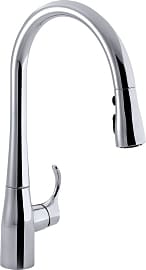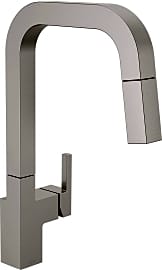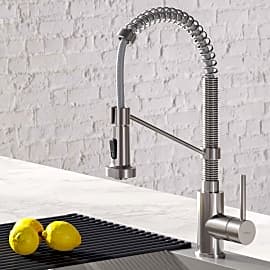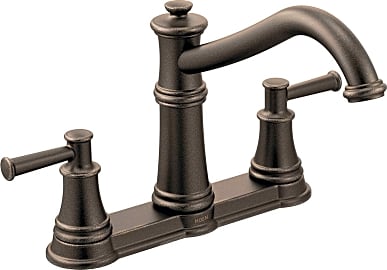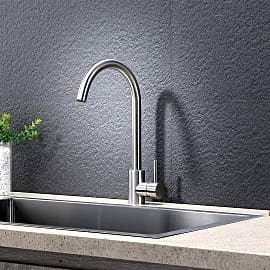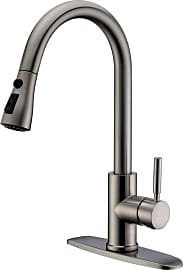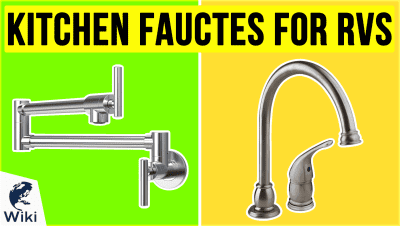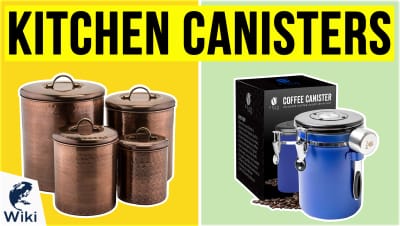The 10 Best Kitchen Faucets

This wiki has been updated 45 times since it was first published in March of 2015. Adding a new faucet to an old sink is one of the fastest and easiest ways to refresh or elevate the look of your kitchen. Whether you want a traditional style or all the latest bells and whistles to make cooking and cleaning easier, the models on our list were chosen to give you a variety of options, from two-handled choices to one that integrates with your smart home. When users buy our independently chosen editorial recommendations, we may earn commissions to help fund the Wiki.
Editor's Notes
December 01, 2020:
Whether you're looking for a smart option, or just want a reliable "dumb" choice, we've included selections here that should fit the bill. When it comes to the former, the Moen Arbor Motionsense and the Delta Trinsic Pro are still great choices to consider; the Moen model has a touch-free operation, while the Delta model is voice-activated. These ensure that you never have to put dough- or meat-covered hands on the faucet, which helps you keep your kitchen sanitary. Pair these with an automatic soap dispenser to further control the spread of foodborne pathogens.
Even though the Kohler Sensate also offers a useful touchless operation, we removed it due to concerns about the solenoid's longevity. But we kept the Kohler Simplice, which is offered in both regular and touch-free models. A highly popular choice, it's available in three finishes, including a handsome matte black.
As for the other traditional models you'll find here, the Moen Belfield and the Delta Junction stand out the most, design-wise. They won't blend in well with every type of decor, as do the relatively simple Wewe High Arc or the Vapsint 360 Swivel, but if you are trying to capture a specific look, they may be just what you need. For a commercial feel, there's the Kraus Bolden. It comes in more finishes than most, including eye-catching split finishes, such as champagne bronze and matte black.
November 22, 2019:
Many of the choices on this list have a more modern style and offer things like touchless on/off and pull-out sprayers, because most cooks value efficiency in the kitchen. These options are beautiful as well and fit in with the decor of popular modern kitchen designs, but we did include an offering that would be at home in a country kitchen.
The Moen Belfield replaces the antique-looking Designers Impressions Pull-Out because although it was offered as a budget-friendly choice, it's too prone to leaking over time. The Moen Belfield costs more but it's rock solid and reliable after an easy installation, while still offering a traditional styling.
For the professional chef's kitchen we added the recently released Delta Trinsic Pro right into the top spot for pairing an industrial modern design with the latest technology that works with Amazon and Google smart hubs.
Special Honors
Kallista For Town The For Town line, designed exclusively for Kallista by Michael B. Smith, might be mistaken for an antique, with its bridge-mounted structure that evokes the styling of the 1930s. There's whimsical HOT and COLD engraved on the handles and the high spout gives great clearance for filling large pots. While this line doesn't emphasize the modern conveniences, this model does include a coordinating side sprayer. kallista.com
In2Aqua Edge Only available through select builders and designers, the In2Aqua brand is produced in Germany with an emphasis on minimalism and quality. With a solid brass construction and ceramic disc technology, they're built with parts of the highest standard and certified Cal Green compliant. This model must be installed by a pro for a valid warranty. in2aqua.com
Waterstone Faucets Traditional Wheel Pulldown The Waterstone Faucets Traditional Wheel Pulldown bills itself as "one-of-a-kind," a description that's certainly hard to argue with. True to its name, it employs an actual wheel to operate the sprayer, one that's large and sure to be the first thing guests notice when they enter your kitchen. Even better, there are over 30 finishes to select from, so you shouldn't have to compromise on your vision. waterstoneco.com
Special Features Of A Quality Kitchen Faucet
As for the times you want your water to run, you probably don't want it to run brown which is why you should get a faucet made from rustproof stainless steel.
For many new homeowners and renovators, by the time they've exhausted their energies selecting flooring materials and bathroom tiles, choosing a kitchen faucet is an afterthought, but it shouldn't be. You may not appreciate a great faucet until you've struggled with a bad one, and then, you'll pick up on the features that make a quality kitchen faucet.
A leaky faucet can be incredibly costly, sometimes wasting 180 showers' worth of water per year. Ceramic disc technology can fend against these leaks. As for the times you want your water to run, you probably don't want it to run brown which is why you should get a faucet made from rustproof stainless steel.
People who wash a lot of dishes by hand need a faucet that has a spray nozzle and hose, which are much more effective at removing grime and grease than a regular stream of water. You should make sure the hose has a magnetic self-docking system so you don't accidentally leave it extended. Faucets with extra high necks are also very useful in kitchen sinks since they leave room below for large pots or piles of dishes.
Some faucets spit out water at unpredictable speeds and inconsistent pressure, causing you to constantly turn them up or down to get a good stream. Faucets with plastic lined hybrid waterways allow for a constant and smooth water flow. Since kitchen faucets can attract a lot of bacteria, it's a good idea to get a nozzle that's made with silicone, which is extremely hygienic.
How To Choose The Best Style For Your Kitchen
There is no right or wrong style of faucet, it just depends on your needs. People who like total control over the pressure and temperature of their water will prefer a two handle faucet, with one handle managing the hot water and one managing the cold. This also offers a very classic look. Some people want as little clutter as possible around their faucet and prefer a one handle model, in which the temperature and pressure are all controlled by just one lever.
For an industrial style kitchen, brushed chrome or wrought iron is best.
While mostly found in commercial buildings, hands-free faucets have been shown to greatly reduce the spread of germs. Most research on the matter pertains to bathroom sinks, but it easily transfers to the kitchen where germs hide everywhere.
As previously mentioned, faucets with tall spouts can be good for running enormous pots under. However, people with low hanging windows or blinds might need a faucet with a low arc. If you have a window sill that juts out over your sink, measure the distance between the surface around your faucet and the bottom of that window sill to make sure your spout will fit.
One should also take personal style into account. Those looking to create an antique aesthetic might like an oil rubbed bronze finish, while the more modern designer could like a chrome finish. People who are creating a bright, uplifting look often like a glacier or ivory finish. For an industrial style kitchen, brushed chrome or wrought iron is best. The handles also affect the aesthetic. In one handle faucets, a top-mounted lever looks more vintage than a side-mounted one.
The History Of Faucets
Faucets have a long history. As early as the 1700s the Ancient Romans were plumbing pioneers, and they used faucets to fill their public baths, cisterns, and some private baths. One handle faucets are a more modern invention since the first models always had two handles. A man named Al Moen is responsible for introducing the single handle faucet in 1937. Moen was inspired when he burnt himself in the hot water of the old two handle bathtub. His faucet was the first to combine temperature and volume control in one operation.
A man named Al Moen is responsible for introducing the single handle faucet in 1937.
In 1945, Landis Perry invented the ball valve faucet. A ball valve depends on a little ball placed inside a cup-shaped opening. When pressure is applied to the ball, the valve opens or closes. The ball valve uses a previous invention — the Quaturn cartridge. This allows a person to stop or start the flow of water by simply turning a valve a quarter of a turn, rather than several rotations.
Later, the company Wolverine Brass would improve upon faucets by adding ceramic discs. These facilitate water control and are more durable than rubber ones. In 1954, Alex Manoogian’s washerless ball valve faucet hit the market. It was called the Delta Faucet, and by 1959 it had sold over one million units in the United States. People also have the Delta name to thank for the simple DIY installation faucets we often see today, and they introduced the first hands-free faucets for residential use.



